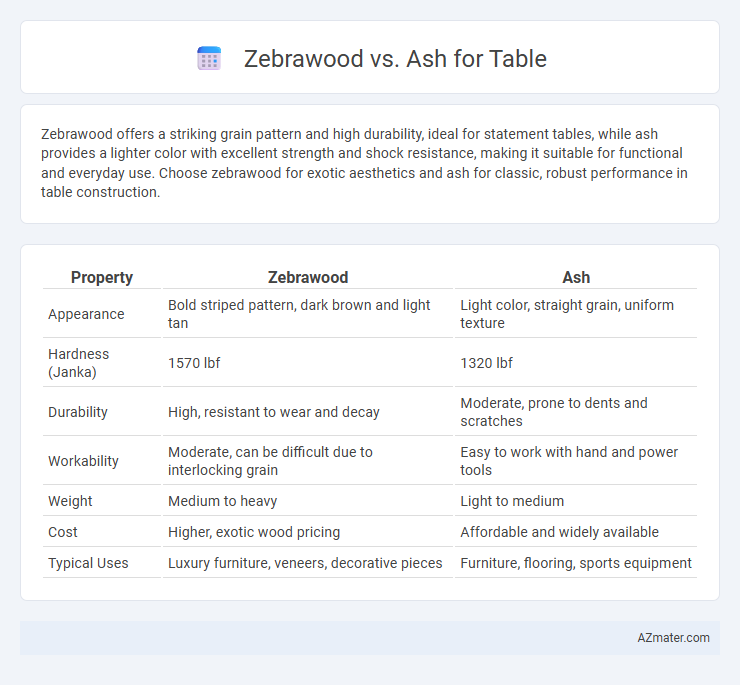Zebrawood offers a striking grain pattern and high durability, ideal for statement tables, while ash provides a lighter color with excellent strength and shock resistance, making it suitable for functional and everyday use. Choose zebrawood for exotic aesthetics and ash for classic, robust performance in table construction.
Table of Comparison
| Property | Zebrawood | Ash |
|---|---|---|
| Appearance | Bold striped pattern, dark brown and light tan | Light color, straight grain, uniform texture |
| Hardness (Janka) | 1570 lbf | 1320 lbf |
| Durability | High, resistant to wear and decay | Moderate, prone to dents and scratches |
| Workability | Moderate, can be difficult due to interlocking grain | Easy to work with hand and power tools |
| Weight | Medium to heavy | Light to medium |
| Cost | Higher, exotic wood pricing | Affordable and widely available |
| Typical Uses | Luxury furniture, veneers, decorative pieces | Furniture, flooring, sports equipment |
Overview: Zebrawood vs Ash for Tables
Zebrawood offers a striking, exotic grain pattern with bold dark stripes, making it ideal for statement tables that emphasize unique aesthetics and durability. Ash provides a lighter color palette with a straight grain, delivering a classic, resilient choice known for its shock resistance and smooth finish. Both woods suit table construction, but Zebrawood prioritizes visual impact while Ash balances strength and subtle elegance.
Origin and Botanical Differences
Zebrawood, primarily sourced from the Microberlinia brazzavillensis tree native to Central Africa, features a distinct, striped grain pattern with a dense, coarse texture. Ash comes from the Fraxinus genus, mainly found in temperate regions of North America and Europe, characterized by lighter color and open, straight grain with a more uniform texture. The botanical differences lie in Zebrawood's tropical hardwood properties contrasted with Ash's temperate hardwood traits, affecting durability and aesthetic appeal for table construction.
Appearance and Grain Patterns
Zebrawood features bold, dark stripes against a pale yellow-brown background, creating a striking and exotic appearance ideal for statement tables. Ash offers a lighter, creamy tone with straight, pronounced grain patterns that provide a classic, clean look suitable for versatile table designs. The contrasting grain patterns--Zebrawood's irregular striping versus Ash's uniform grain--affect the table's visual impact and style, appealing to different aesthetic preferences.
Durability and Hardness
Zebrawood offers exceptional durability with a Janka hardness rating around 1,290, making it highly resistant to dents and scratches, ideal for heavy-use tables. Ash wood, with a Janka hardness of approximately 1,320, is similarly durable but provides more flexibility and shock resistance due to its semi-hard nature. Both woods are strong choices, but Zebrawood's dense grain pattern gives it ultra-resilience, while Ash delivers a balanced combination of hardness and elasticity for long-lasting table performance.
Workability and Machining
Zebrawood offers a unique challenge in workability due to its dense, interlocked grain that can cause tear-out and blunt tools quickly, requiring sharp blades and slower feed rates during machining. Ash, known for its straight grain and moderate density, provides excellent workability and ease of machining, making it a preferred choice for both hand tools and power tools in table construction. While Zebrawood provides superior durability and striking aesthetics, Ash combines smoother machining processes with reliable strength, optimizing efficiency in woodworking projects.
Finishing and Staining Capabilities
Zebrawood offers a striking grain pattern that absorbs stains unevenly, often resulting in a bold, natural look ideal for clear or light finishes that highlight its distinctive striping. Ashwood provides a smoother, more uniform surface that readily accepts stains, allowing for consistent color application and versatility in achieving both light and dark finishes. Both woods respond well to finishing treatments, but Zebrawood's open pores may require additional sealing for a flawless finish compared to the tighter grain of Ash.
Cost Comparison
Zebrawood tables generally cost more than ash due to the exotic nature and limited availability of zebrawood, often priced between $25 to $35 per board foot compared to ash's $5 to $10 per board foot. The higher price of zebrawood reflects its distinctive striped grain and durability, making it a premium choice for furniture. Ash offers a cost-effective alternative with good strength and a lighter color, appealing to budget-conscious buyers seeking quality without the exotic wood premium.
Environmental Impact and Sustainability
Zebrawood, sourced mainly from West Africa, faces challenges due to habitat loss and limited sustainable harvesting initiatives, leading to concerns about its environmental impact. Ash, commonly grown in North America and Europe, benefits from well-established sustainable forestry practices that minimize deforestation and promote ecosystem health. Choosing ash for tables supports lower carbon footprints and better forest regeneration compared to the more exotic and less regulated zebrawood.
Best Uses in Table Design
Zebrawood offers a striking, striped grain pattern ideal for statement pieces and accent tables, making it perfect for modern and exotic table designs. Ash features a lighter color with a straight grain, providing excellent durability and shock resistance, suitable for dining tables and work surfaces requiring longevity. Both woods excel in different applications: Zebrawood emphasizes aesthetic appeal, while Ash prioritizes functionality and strength in table construction.
Which is Better: Zebrawood or Ash?
Zebrawood offers a striking, exotic grain pattern ideal for statement tables, while Ash provides a lighter color with excellent strength and shock resistance, making it a practical choice for everyday use. Zebrawood's density and durability support longevity but may require more maintenance due to its porosity, whereas Ash's flexibility and ease of finishing suit versatile design preferences. Selecting between Zebrawood and Ash depends on whether visual impact or functional resilience is prioritized for the table's intended environment.

Infographic: Zebrawood vs Ash for Table
 azmater.com
azmater.com